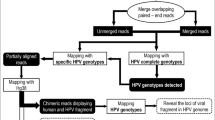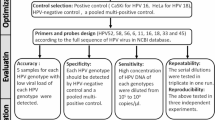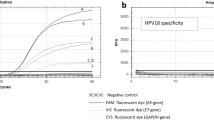Abstract
The possible correlation between HPV16 and HPV18 genomic copies with the grade of cervical lesions needs more investigations. The aim of this study was to quantify genomic copies of HPV16 and 18 simultaneously and to find out the correlation between genomic copies numbers and different grades of lesions. Therefore, a total of 102 formalin-fixed and paraffin-embedded tissue specimens, 33 LSILI, 43 HSIL, and 26 squamous/adenocarcinoma were subjected to DNA extraction. The β-globin gene was selected to qualify the extracted DNA as well as normalization of viral titers using Taq-Man real-time PCR. The presence HPV16 and/or 18 were screened in tissue samples by nested PCR method, then an in- house Taq-Man Duplex real-time PCR assay was employed to quantify their genomic copies. The mean age of participants was 43 ± 13. Out of 102, 80 samples were positive for HPV16 and/or 18 DNA. There was a statistically significant association between HPV16 genomic copies and progression of cervical lesions (P < 0.001). In contrast, no such an association was found in the case of HPV18 (P = 0.51). Moreover, with 95% confidence intervals, 2.3–4 genomic copies of HPV16 genome/cell could be applicable to distinguish LSIL from HSIL and SCC. In conclusion, quantification of HPV16 genomic copy number showed a close association with progression of cervical lesion. Furthermore, HPV16 genomic copies of 4 copies/cell could be a set point to differentiate LSIL from HSIL.

Similar content being viewed by others
References
Bakhtiarizadeh S, et al. Almost complete lack of human cytomegalovirus and human papillomaviruses genome in benign and malignant breast lesions in Shiraz, Southwest of Iran. Asian Pac J Cancer Prev. 2017;9(12):3319–24.
Barbosa M, Schlegel RJO. The E6 and E7 genes of HPV-18 are sufficient for inducing two-stage in vitro transformation of human keratinocytes. Oncogene. 1989;4(12):1529–32.
Briolat J, et al. HPV prevalence, viral load and physical state of HPV-16 in cervical smears of patients with different grades of CIN. Int J Cancer. 2007;121(10):2198–204.
Broccolo F, et al. Prevalence and viral load of oncogenic human papillomavirus types associated with cervical carcinoma in a population of North Italy. J Med Virol. 2009;81(2):278–87.
Burd EM. Human papillomavirus and cervical cancer. Clin Microbiol Rev. 2003;16(1):1–17.
Cancer, I.I.C.o.H.a. Human papillomavirus and related diseases report. ICO Information Centre on HPV and Cancer, 2015.
Carcopino X, et al. Significance of HPV 16 and 18 viral load quantitation in women referred for colposcopy. J Med Virol. 2012;84(2):306–13.
Carrillo-García A, et al. Impact of human papillomavirus coinfections on the risk of high-grade squamous intraepithelial lesion and cervical cancer. Gynecol Oncol. 2014;134(3):534–9.
de Jesus SP, et al. A high prevalence of human papillomavirus 16 and 18 co-infections in cervical biopsies from southern Brazil. Braz J Microbiol. 2018;49:220–3.
Del Río-Ospina L, et al. The DNA load of six high-risk human papillomavirus types and its association with cervical lesions. BMC Cancer. 2015;15(1):100.
Dickson EL, et al. Cervical cytology and multiple type HPV infection: a study of 8182 women ages 31–65. Gynecol Oncol. 2014;133(3):405–8.
Dong L, et al. Human papillomavirus viral load as a useful triage tool for non-16/18 high-risk human papillomavirus positive women: a prospective screening cohort study. Gynecol Oncol. 2018;148(1):103–10.
Dong B, et al. Type-specific high-risk human papillomavirus viral load as a viable triage indicator for high-grade squamous intraepithelial lesion: a nested case- control study. Cancer Manag Res. 2018;10:4839–51.
Eghbali SS, et al. Oncogenic human papillomavirus genital infection in southern Iranian women: population-based study versus clinic-based data. Virol J. 2012;9(1):194.
Farhadi A, et al. High-risk human papillomavirus infection in different histological subtypes of renal cell carcinoma. J Med Virol. 2014;86(7):1134–44.
Fitzmaurice C, et al. Global, regional, and national cancer incidence, mortality, years of life lost, years lived with disability, and disability-adjusted life-years for 32 cancer groups, 1990 to 2015: a systematic analysis for the global burden of disease study. JAMA Oncol. 2017;3(4):524–48.
Flores R, et al. Cross-sectional analysis of oncogenic HPV viral load and cervical intraepithelial neoplasia. Int J Cancer. 2006;118(5):1187–93.
Gao G, Smith DI. Human papillomavirus and the development of different cancers. Cytogenet Genome Res. 2017;150:185–93.
Guan P, et al. Human papillomavirus types in 115,789 HPV-positive women: a meta-analysis from cervical infection to cancer. Int J Cancer. 2012;131(10):2349–59.
Hesselink AT, et al. High-risk human papillomavirus DNA load in a population-based cervical screening cohort in relation to the detection of high-grade cervical intraepithelial neoplasia and cervical cancer. Int J Cancer. 2009;124(2):381–6.
Ho CM, et al. Type-specific human papillomavirus oncogene messenger RNA levels correlate with the severity of cervical neoplasia. Int J Cancer. 2010;127(3):622–32.
Khorasanizadeh F, et al. Epidemiology of cervical cancer and human papilloma virus infection among Iranian women—analyses of national data and systematic review of the literature. Gynecol Oncol. 2013;128(2):277–81.
Kiani SJ, et al. Detection and typing of human papilloma viruses by nested multiplex polymerase chain reaction assay in cervical cancer. Jundishapur J Microbiol. 2015;8(12):e26441.
Mahmoodvan S, et al. No detection of Streptococcus g allolyticus and Helicobacter pylori in colorectal cancer tissue samples in Shiraz. Iran. Iran J Cancer Prev. 2017;10(1):e6337.
Mahmoudvand S, et al. Presence of human papillomavirus DNA in colorectal cancer tissues in Shiraz, Southwest Iran. Asian Pac J Cancer Prev APJCP. 2014;16(17):7883–7.
Mayrand M-H, et al. Human papillomavirus DNA versus Papanicolaou screening tests for cervical cancer. N Engl J Med. 2007;357(16):1579–88.
Mittal S, et al. Risk of high-grade precancerous lesions and invasive cancers in high-risk HPV-positive women with normal cervix or CIN 1 at baseline—a population-based cohort study. Int J Cancer. 2017;140(8):1850–9.
Ramírez-Flores M, et al. HPV 16 and 18 viral loads are greater in patients with high-grade cervical epithelial lesions. Eur J Gynaecol Oncol. 2016;37(5):644–8.
Serrano B, et al. Epidemiology and burden of HPV-related disease. Best Pract Res Clin Obstet Gynaecol. 2017;47:14–26.
Villa LL, Schlegel RJV. Differences in transformation activity between HPV-18 and HPV-16 map to the viral LCR-E6-E7 region. Virology. 1991;181(1):374–7.
Wu Z, et al. Association between human papillomavirus (HPV) 16, HPV18, and other HR-HPV viral load and the histological classification of cervical lesions: results from a large-scale cross-sectional study. J Med Virol. 2017;89(3):535–41.
Acknowledgements
The present study was extracted from the thesis written by Negar Joharinia, and was financially supported by Shiraz University of Medical Sciences (Grant No: 94-10934). Special thanks to Prof. Abbas Behzad-Behbahani and the staff of Diagnostic Laboratory Sciences and Technology Research Center for their assistance. The authors wish to thank Mr. H. Argasi at the Research Consultation Center (RCC) of Shiraz University of Medical Sciences for his invaluable assistance in editing this manuscript.
Author information
Authors and Affiliations
Corresponding author
Ethics declarations
Conflict of interest
All the authors declare that they have no conflict of interest.
Additional information
Publisher's Note
Springer Nature remains neutral with regard to jurisdictional claims in published maps and institutional affiliations.
Rights and permissions
About this article
Cite this article
Joharinia, N., Farhadi, A., Hosseini, S.Y. et al. Association of HPV16 and 18 genomic copies with histological grades of cervical lesions. VirusDis. 30, 387–393 (2019). https://doi.org/10.1007/s13337-019-00545-2
Received:
Accepted:
Published:
Issue Date:
DOI: https://doi.org/10.1007/s13337-019-00545-2




